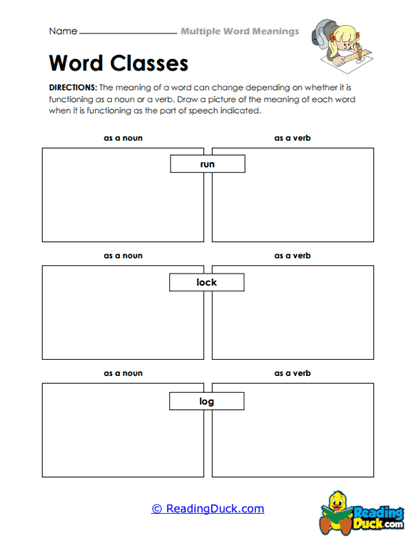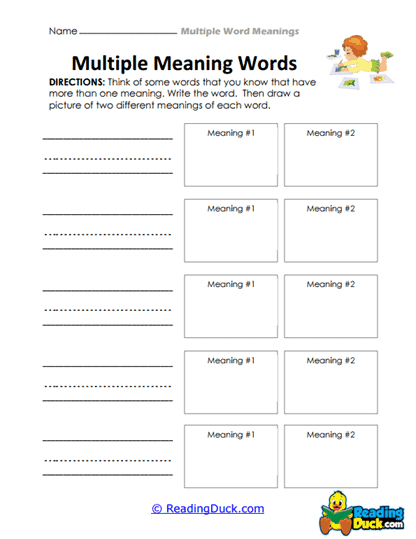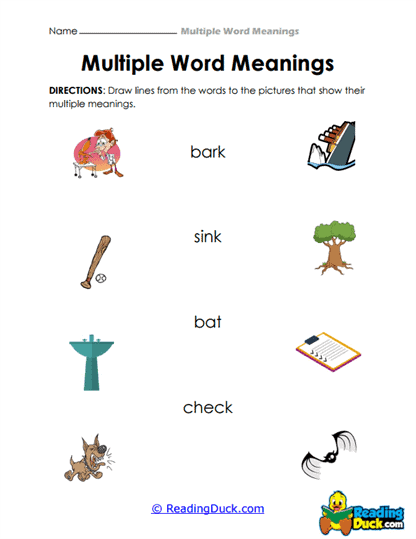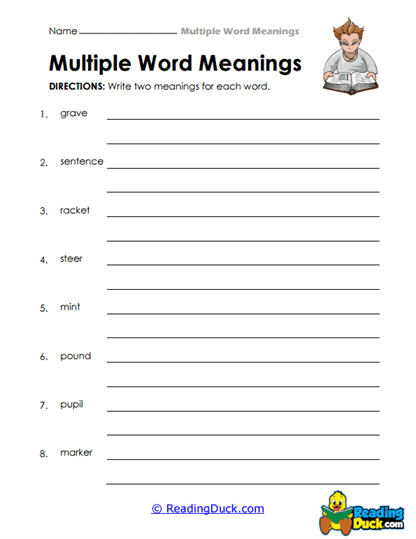Multiple Word Meanings Worksheets
About Our Multiple Word Meanings Worksheets
Our Multiple Word Meanings Worksheets are designed to help students master the understanding and usage of words that have more than one meaning. Many words in the English language can change meaning based on context, and learning how to identify these variations is a critical skill in language development. Understanding multiple word meanings enables students to become more flexible in their comprehension and usage of vocabulary, improving both their reading and writing skills.
These worksheets are presented in PDF format, making them easy to download, print, and integrate into any learning environment. Each worksheet includes a downloadable answer key, ensuring that grading and review are simple and effective. By mastering the ability to recognize and apply multiple word meanings, students will significantly enhance their vocabulary and language comprehension, empowering them to navigate complex texts with confidence.
Exploring the Concept of Multiple Word Meanings
Many words in English can have more than one meaning depending on how they are used in a sentence. These words, known as polysemous words, are common in everyday language and can be found in everything from casual conversation to academic texts. For students, understanding how a single word can take on different meanings based on context is a crucial step in developing language proficiency.
When teaching multiple word meanings, it is important to explain the following key points:
- Polysemy: This refers to words that have multiple meanings. For example, the word bat can refer to a flying mammal or a piece of sports equipment used in baseball.
- Contextual Clues: Students must learn to rely on the context of the sentence to determine which meaning of a word is being used. For instance, “I saw a bat in the cave” and “He hit the ball with a bat” illustrate different meanings of the same word based on the sentence.
- Flexibility in Understanding: Words like run can have a wide variety of meanings, such as "to sprint," "to manage," or "a continuous series." Students must learn to adapt their understanding of a word based on its surrounding text.
By understanding how context shapes meaning, students can more effectively interpret sentences and passages. This skill becomes particularly useful in reading comprehension and writing, where words often take on nuanced meanings that require careful analysis. The ability to recognize multiple meanings is fundamental to advancing vocabulary and communication skills.
Building Vocabulary and Language Skills Through Multiple Word Meanings
Mastering the ability to identify and understand words with multiple meanings is essential for students to build a richer, more dynamic vocabulary. The Multiple Word Meanings Worksheets focus on helping students develop the skills to determine which definition of a word applies in a given context, improving their overall language comprehension.
These worksheets support vocabulary development in several ways:
- Contextual Analysis: By working through examples of words used in different sentences, students learn to analyze context clues to determine meaning. For example, in the sentences “The bank is closed” and “He sat by the riverbank,” students must recognize that bank has two different meanings based on the setting.
- Strengthening Word Recognition: Practicing with polysemous words helps students become more familiar with the variety of ways common words are used, enabling them to recognize and recall words more quickly. For example, the word right can mean a direction, correctness, or a legal entitlement, and understanding this variety builds flexibility in word recognition.
- Deepening Word Knowledge: By exploring multiple meanings of common words, students gain a deeper understanding of how language works. They come to appreciate the versatility of words like lead, which can mean “to guide” or “a type of metal,” and this understanding enriches their overall language skills.
For example, the word bark can mean the sound a dog makes or the outer layer of a tree. Recognizing the differences between these meanings based on context is an important skill that helps students read with greater accuracy and interpret language more effectively.
Flexible Use Across Learning Environments
Our Multiple Word Meanings Worksheets are designed for versatile use, making them ideal for various learning settings. Whether used in the classroom, as part of homework assignments, or for independent study, these worksheets offer students the opportunity to engage with multiple word meanings in a structured, accessible format.
- In-Class Activities: Teachers can incorporate these worksheets into lessons focused on vocabulary development, reading comprehension, or context analysis. The worksheets can serve as a hands-on activity to reinforce lessons about word flexibility and the importance of understanding context in language.
- Homework Assignments: These worksheets are perfect for homework assignments, allowing students to practice identifying multiple word meanings at their own pace. This independent work reinforces classroom learning and encourages students to apply critical thinking skills outside of school hours.
- Independent Study: Students looking to improve their vocabulary and comprehension skills independently will find these worksheets a valuable resource. The PDF format allows for easy downloading and printing, making them convenient for study sessions at home or on the go.
Each worksheet includes a downloadable answer key, making it simple for teachers and parents to check students’ progress and provide quick feedback. The flexibility of these worksheets ensures they can be used in any learning environment, giving students the opportunity to improve their vocabulary and comprehension skills at their own pace.
Real-World Importance of Mastering Multiple Word Meanings
Understanding the multiple meanings of words is a critical skill for both academic success and effective communication in everyday life. Words with multiple meanings appear frequently in written texts and spoken language, and the ability to interpret them correctly is essential for clear and accurate understanding.
Here are some real-world applications of mastering multiple word meanings:
- Improved Reading Comprehension: Many written texts, from literature to news articles, contain words with multiple meanings. Students who can interpret these words correctly will have an easier time understanding the overall message of the text. For example, when reading a news article, understanding whether strike refers to a work stoppage or a physical action is essential for comprehension.
- Better Writing Skills: Students who understand multiple word meanings can use vocabulary more effectively in their writing, choosing the right word for the right context. For example, knowing that light can mean “not heavy” or “illumination” allows writers to use the word in a way that adds depth to their description.
- Effective Communication: In everyday conversations, words with multiple meanings are common, and the ability to interpret them correctly ensures clear communication. For instance, when someone says “I saw the band,” knowing whether band refers to a musical group or something you wear on your wrist depends on the context of the conversation.
In professional settings, understanding multiple word meanings can be especially useful in avoiding misunderstandings. For example, in law or business, a word like contract can refer to both a formal agreement and the act of shrinking, so knowing which meaning applies is essential for accurate interpretation.
Preparing for Standardized Tests with Multiple Word Meanings
Mastering words with multiple meanings is a key skill for success on standardized tests such as the SAT, ACT, and TOEFL, where vocabulary comprehension plays a critical role. The Multiple Word Meanings Worksheets help students practice identifying the correct meaning of a word based on its context, a skill that is frequently tested in these exams.
Here’s how these worksheets support standardized test preparation:
- Context Clues: Many standardized tests include vocabulary questions that ask students to determine the meaning of a word based on its use in a sentence. By practicing with multiple word meanings, students learn to rely on context clues to choose the correct definition, improving their performance on these types of questions.
- Vocabulary Expansion: The worksheets introduce students to common polysemous words that may appear on tests. Familiarity with these words helps students approach vocabulary sections with greater confidence, as they have already practiced interpreting multiple meanings.
- Critical Thinking: Tests often assess a student’s ability to think critically about language, and understanding multiple word meanings helps students develop the analytical skills needed to decipher complex passages or answer nuanced questions.
For example, a test question might ask students to determine the meaning of the word current in two different sentences: “The current was strong in the river” and “He stays informed about current events.” By understanding that current can mean both a flow of water and something happening in the present, students can answer the question correctly.
Strengthening Vocabulary with Multiple Word Meanings
Our Multiple Word Meanings Worksheets provide an engaging and effective way for students to build vocabulary, improve reading comprehension, and strengthen their ability to interpret language accurately. Available in PDF format, these worksheets are designed for flexible use in classrooms, as homework assignments, or for independent study.
By mastering the ability to recognize and apply multiple word meanings, students gain valuable language skills that extend beyond vocabulary lessons. They become better readers, writers, and communicators, equipped to handle complex texts and conversations in both academic and real-world contexts. Understanding how words shift meaning based on context gives students the tools they need to approach new vocabulary with confidence and interpret language more effectively.
Whether preparing for standardized tests or simply improving their vocabulary, students will benefit from the practical skills offered by these worksheets. Through regular practice, they will develop the ability to analyze language in depth, enhancing their overall communication abilities and setting them up for success in future academic and professional endeavors.









